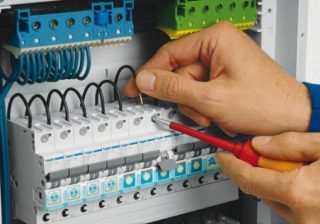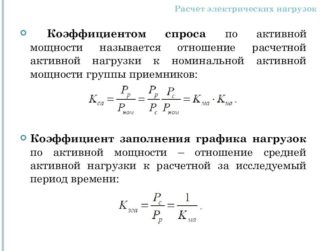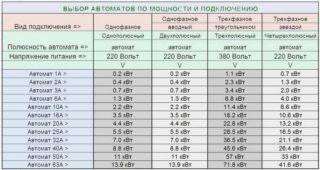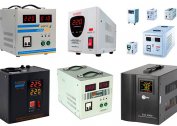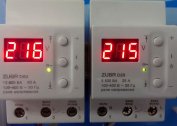The concept of “load” in electric networks is inextricably linked with the need to protect them from current overloads and short circuits. To solve the problems associated with the operation of power lines, switching circuits provide special protective devices. One of such devices is a circuit breaker, the rating of which is selected depending on the operating mode of the load and the parameters of the supply line itself. To choose an automatic machine according to the cable section, you will need to get acquainted with the functions that it performs on the network.
Circuit breaker functions
According to the EMP, the main function of automatic disconnecting devices is to protect the mains from short circuit and overloads. This device disconnects the consumer from the line when the current exceeds the specified nominal value (set point) for it. At the same time, it should not be triggered when the current load is permissible for it (while turning on the iron and hob, for example).
The function of the line fuse is also manifested in the protection of the power cable from thermal destruction due to the ignition of its shell and the subsequent fire. Such situations are quite possible, since under short-circuit conditions the currents in the line reach thousands of amperes. None of the well-known brands of cable products at these loads can withstand even a few minutes. Not to mention ordinary products with a cross section of 2.5 square meters. mm, traditionally used for arranging electrical wiring in private homes and city apartments.
Proper design of a protective circuit breaker is of great importance for ensuring the safe operation of the local electrical network. The correct approach to choosing the ratings of automatic machines for cable cross-section plays a paramount role in this matter.
Factors affecting the choice of the required face value
The calculation of the operating parameters of the wire and the machine is permissible only if all the nuances relating to the operation of the power grid are taken into account. This approach will help to avoid possible errors when choosing a protective device.
Determination of total power consumption
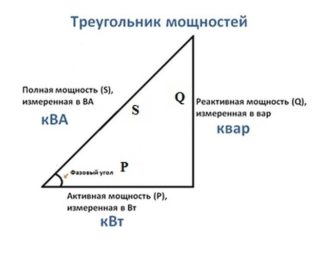 One of the main parameters of the electric network is the maximum power consumption of all active and reactive loads connected to it. When calculating this indicator, simply summing the values indicated in the device passport is not allowed. This is due to the different nature of their action in the line. Any device connected to a power outlet or directly to a substation’s power cable is characterized by its power consumption, estimated in kilowatts (kW). This value determines the energy that is converted in this device into the work done by him or her and for which the user pays on the meter.
One of the main parameters of the electric network is the maximum power consumption of all active and reactive loads connected to it. When calculating this indicator, simply summing the values indicated in the device passport is not allowed. This is due to the different nature of their action in the line. Any device connected to a power outlet or directly to a substation’s power cable is characterized by its power consumption, estimated in kilowatts (kW). This value determines the energy that is converted in this device into the work done by him or her and for which the user pays on the meter.
A known category of loads, which include capacitive and inductive elements. They are called reactive and do not take part in the formation of the total consumed power - during operation they simply pump energy from the network and back. However, from the point of view of choosing an automatic machine over the cable section, this current component is necessarily taken into account.
Sometimes the full or rated power, taking into account the active and reactive component, is also indicated in the passport. The current flowing in the load circuit is calculated in this case based on its value (it is divided by the effective voltage of 220 or 380 volts).
Increased starting currents
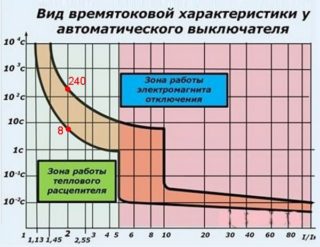 In certain types of home appliances (in washing machines, household compressors), there are built-in electric motors, characterized by high starting currents. Their value for a very short time (no more than 3 seconds) can many times exceed the operating values observed in the steady state. The resulting short-term surge, as a rule, does not cause the thermal release of the machine to trip.
In certain types of home appliances (in washing machines, household compressors), there are built-in electric motors, characterized by high starting currents. Their value for a very short time (no more than 3 seconds) can many times exceed the operating values observed in the steady state. The resulting short-term surge, as a rule, does not cause the thermal release of the machine to trip.
However, its electromagnetic part, which is responsible for overcurrents of a short circuit, in real conditions often trips and turns off the device. Very often this happens in dedicated three-phase power lines with machine tools connected to them (in private homes). In this case, it is necessary to determine the magnitude of the starting pulse and provide for the use of a class “D” machine.
Demand factor
For circuits with connected loads equivalent in energy intensity, the concept of a “demand coefficient” is introduced, denoted as “ks”. The meaning of its application is that all devices at the same time are never connected to the network and a simple summation of their capacities will give an overestimated figure. The coefficient used for this purpose assumes a value of unity or a little less.
With this in mind, the calculated power (Pr) for all serviced devices is found by the formula:
Pr = ks x Swhere S - its total value before the amendment.
It makes sense to use this coefficient in office and retail premises with a large volume of office equipment and other equipment.
For modern one-room apartments with a limited number of consumers, it is usually not taken into account. When the total power of all consumers is determined, you can proceed to the procedure for selecting the machine according to the maximum current load. Its working or nominal value is determined by Ohm's law:
I = S / 220 Volts - for one phase.
I = S / (1.73x380) - for a three-phase network.
The coefficient 1.73 takes into account the inductive nature of the load.
Calculation of the parameters of the machine
For any electrical network connected to a local distribution cabinet, the following inequality must be fulfilled:
In <= Ip / 1.45
Here, In corresponds to the rated current of the machine, and Ip is its maximum permissible value for the wiring itself. Compliance with the requirements of this inequality is the main condition for the correct choice of the “machine-cable” pair, which excludes overheating and emergency ignition of the wiring.
The rated current can be calculated either from the known total load, or from the cross section of the wires of the existing wiring.
If the sketch of the wiring in the apartment has already been drawn, and it has not yet reached the laying, the procedure looks like this:
- The total current of all devices connected to the mains is calculated (according to the scheme).
- An automaton with a suitable value is selected.
- According to the table of correspondence of sections and currents, the cable of the desired brand and type is selected.
When the wiring is already laid, the necessary operations will be greatly simplified. According to the known section of the cable laid in a certain way, the limit current is determined from the correspondence tables. After that, according to the above formula, the value of the nominal value of the machine is calculated.
Choose between multiple options
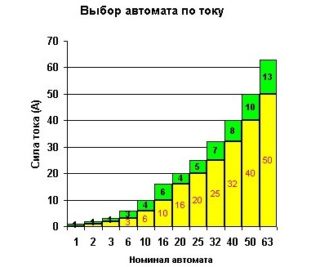 Situations are possible when, when choosing an automaton with the required face value, an alternative arises of selecting two close values. So with a total power consumption of 4 kW (18 Amps), wiring with a cross section of copper conductors of 4 mm2 is suitable. In this case, it is allowed to put the device at 20 or 25 Amps.
Situations are possible when, when choosing an automaton with the required face value, an alternative arises of selecting two close values. So with a total power consumption of 4 kW (18 Amps), wiring with a cross section of copper conductors of 4 mm2 is suitable. In this case, it is allowed to put the device at 20 or 25 Amps.
When using several levels of protection, choose automatic machines so that the value of the upper level rating exceeds the same indicator for devices of a lower status. On the other hand, choosing a smaller value is advantageous in that in this case the thermal release will trip faster if the current exceeds the permissible value.
Calculations of the machine according to the cable section can be done online. To do this, there are many sources presented on the Internet.
